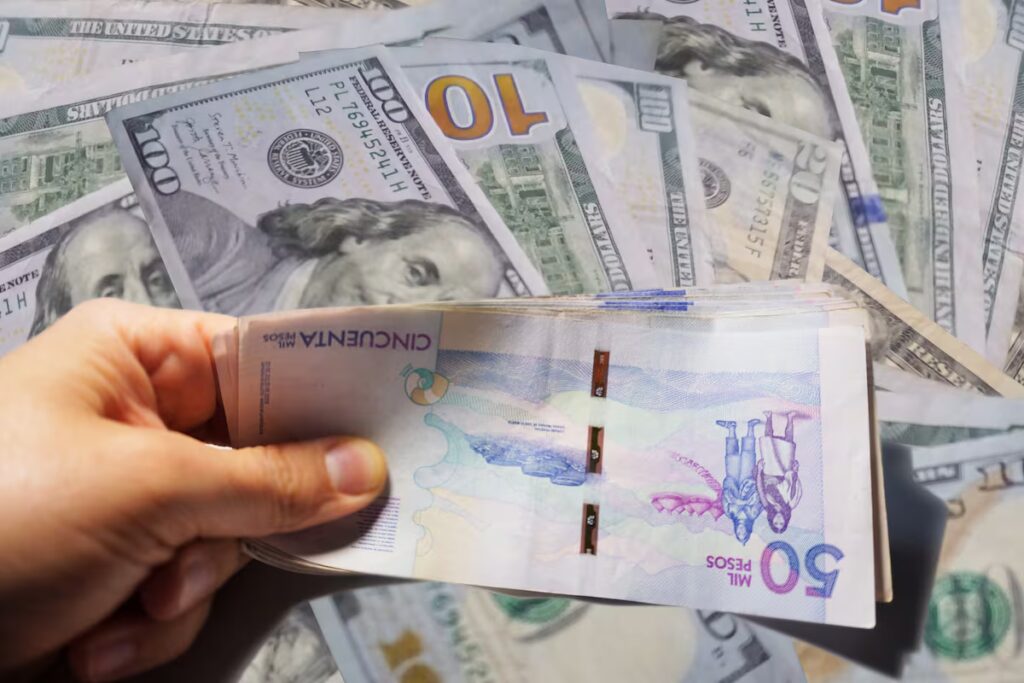
Tomás Salazar lives in Bogotá and earns a dollar salary because he works with US-based retail companies. “I’m happy that the peso is strengthening, even if my salary is affected. As a Colombian I’m happy that the currency is strong,” he comments. Almost 500 kilometers from the capital, in Palmira (Valle del Cauca), Norma Soto also says she feels “happiness”, but because she has been able to “buy dollars at a good price”, little by little, in view of a trip she will take in December. There’s a lot of talk on the streets of Colombia about the greenback, and with good reason.
The dollar has depreciated 13.5% against the Colombian peso this year, according to the representative market rate (TRM), an increase that exceeds the global trend. The dollar, weakened around the world by mistrust stemming from Donald Trump’s protectionist policies – and recently Federal Reserve rate cuts – is losing 8% of its value against a basket of currencies, according to the DXY gauge. But there is something else in Colombia: a financial engineering operation directed by Javier Cuéllar, director of the Public Credit Directorate of the Ministry of Finance.
Cuéllar, who the market sees as a risky official, a cowboyhas devised a strategy that combines the use of financial derivatives (i.e. contracts tied to the price of another asset), bond buybacks and issuing new debt. This is an operation known as total return swaps (TRS), with which the government borrows low-cost dollars using its own bonds as collateral. With the new money, the government buys back its expensive debt and sells another portion of the dollars on the local market to have enough money to pay for its daily operations. In total, there is about $9 billion issued in debt in other currencies, such as Swiss francs or euros, as well as pesos.
Germán Cristancho, head of economic research at Davivienda Corredores, comments that if the fall of the dollar has various causes, the Public Credit operation “could have generated a distortion of the exchange rate of almost 6%”. The director of the Bank of the Republic, Leonardo Villar, also contemplated this thesis: “In the last three months the process of appreciation of the peso has been more intense than that of other currencies, which is perhaps explained to a significant extent by the debt management operations of the General Treasury of the Nation and the monetization of external financial resources to cover the needs generated by the fiscal deficit”, he commented on November 12.
At the end of August, in the midst of an intense phase of the operation, the dollar fell in Colombia faster than in the region and, at times, even bucking the global trend. “Since August 26, the dollar has fallen by almost 8%, below 3,700 pesos, while the DXY index has increased by 2%,” explains Cristancho. “This misalignment coincided with massive foreign currency sales by the government, which totaled nearly $5 billion in four months,” explains the analyst. The economic research unit of Bancolombia estimates the operation at 4,233 million dollars between September and October. “In December, the government could receive another billion dollars in loans, susceptible to monetization,” they warn.
According to experts, the Ministry’s strategy has mixed results. On the one hand, the premium required by investors to buy Colombian debt has been reduced by almost a percentage point this year, which lowers the cost of debt and signals confidence in the country’s ability to meet its obligations. Cuéllar commented to Bloomberg that thanks to these operations, the public debt balance fell by 39 trillion pesos (about 10 billion dollars).
The government could monetize an additional $1 billion in December.
But Bancolombia underlines that this is a reduction in net debt, a figure in which liquidity is subtracted from loans, which has in fact fallen to 57.5% of GDP; while gross debt, the total value of bonds, increased to 64.9% of GDP. This reflects the part of the operations that sought to improve the liquidity of the executive. Laura Fajardo, foreign exchange analyst at Acciones y Valores, completes the analysis: “The strategy works in the short term because it reorganizes the portfolio and softens maturities, but it does not structurally reduce the cost of debt; this depends on the deficit and fiscal credibility.”
Other explanations
In addition to public credit operations, other forces explain the strength of the Colombian peso. The first is monetary policy. Since April, the Bank of the Republic has maintained the intervention rate at 9.25%, which has transformed Colombia into a magnet for foreign capital. The difference in interests compared to the United States determines the situation carry trade: investors who borrow in dollars and convert them into pesos to take advantage of high rates, in a self-reinforcing cycle that has been further promoted. There are favorable factors for this to continue, as members of the Issuer’s Board of Directors have reiterated that they may increase rates if inflation accelerates. This, according to Fajardo, “strengthens the expectation of higher rates for longer.”
A second reason lies in remittances, which according to BBVA Research data already represent 3% of GDP. But not all is calm: typical uncertainty to door Elections and low investments continue to weigh on expectations, and any change in the board could end in a reassessment that for some is temporary: “The operation has avoided looking at the real fundamentals of the country’s economy,” warns César Pabón, an analyst at Corficolombiana, who describes the strength of the peso as a “temporary anesthesia.”
The perception that the dollar is cheap has established itself on the markets, as 75% of institutional clients interviewed by Davivienda believe. Expectations have aligned with this sentiment: the projection for December fell from 4,000 to 3,900 pesos per dollar in the Fedesarrollo financial opinion poll. Pabón, although he warns that analysts tend to avoid dollar forecasts because “it is very likely” that it will reach the target, goes in the opposite direction: “The Ministry’s operation cannot last forever. We expect each dollar to be worth around 4,000 pesos at the end of the year,” he says.
Fajardo explains that 2026 will be more challenging: “The government is unlikely to replicate monetizations without additional external debt, and the peso’s attractiveness will reduce as the Fed advances its cuts.” And he specifies: “The next year will be a year in which the market will look, rather than at flows, at fiscal credibility, monetary policy and the signals of the electoral process”.
The short-term forecasts, however, keep Soto happy, who will have a good cushion to spend on vacation. Salazar, however, has already taken precautions: “I started looking for income in pesos to cushion the blow,” he comments, given Alianza y Valores’ forecasts that the dollar will trade between 3,720 and 3,880 pesos at the end of the year.





